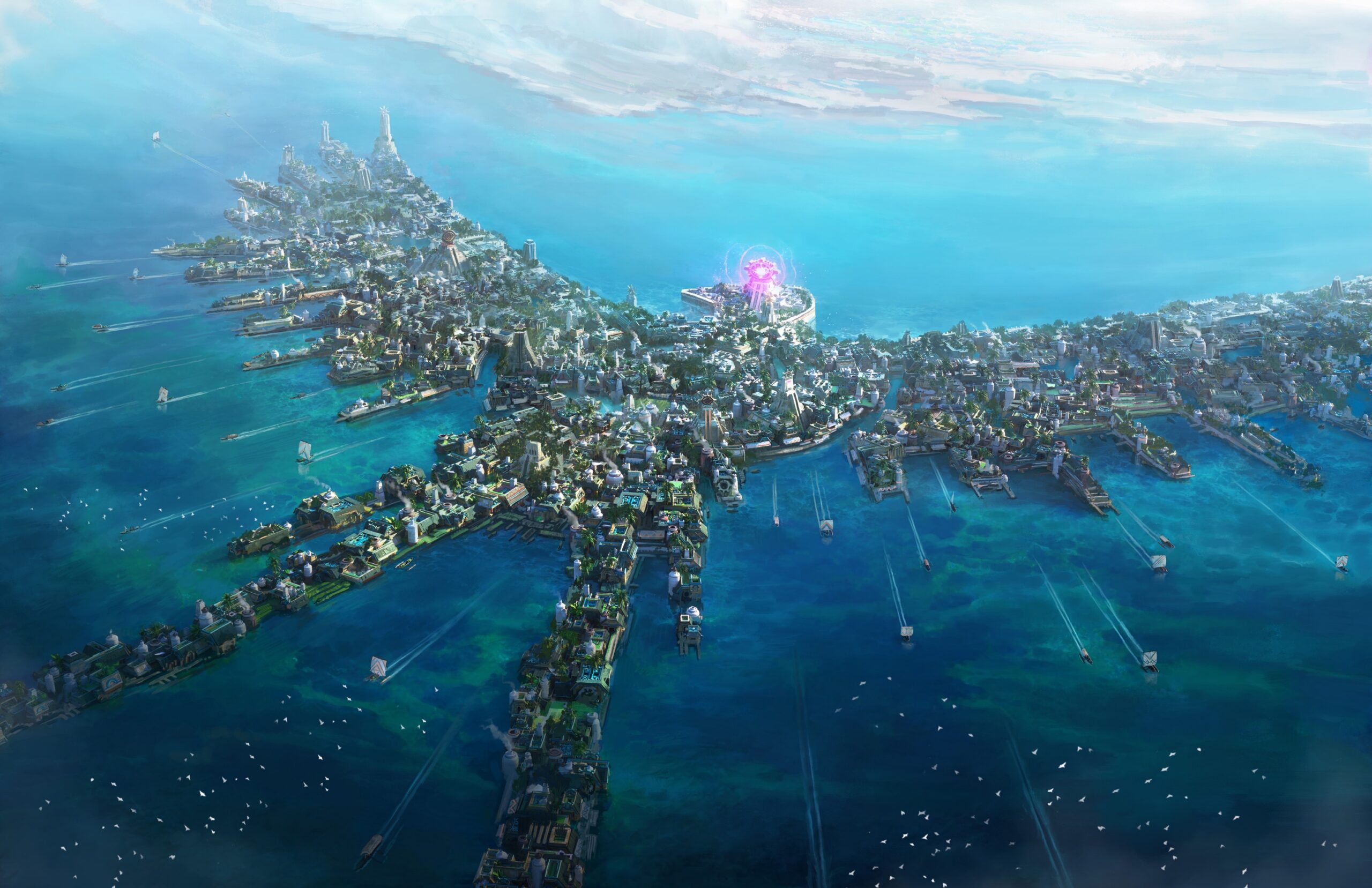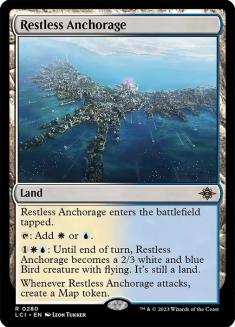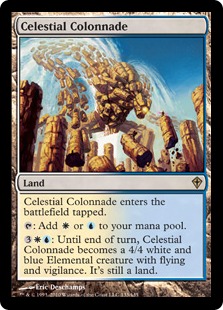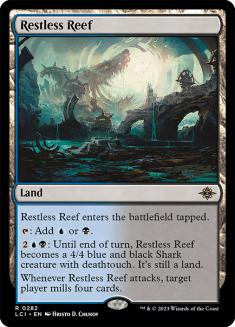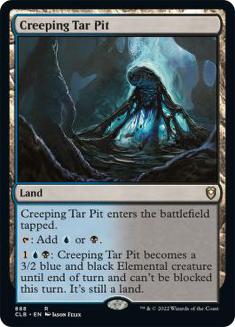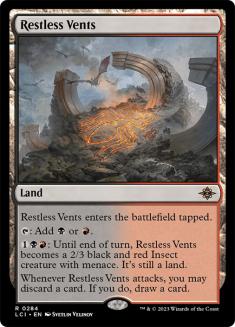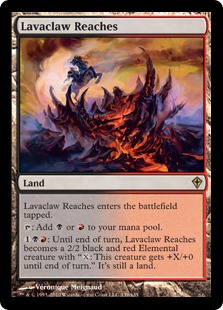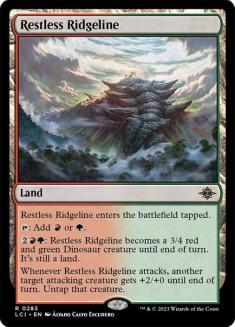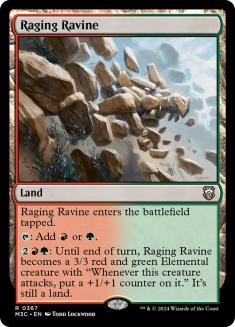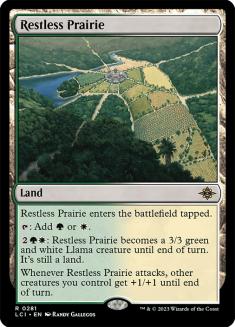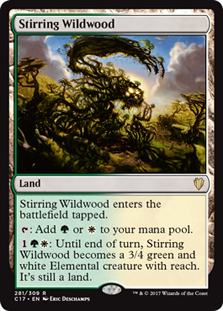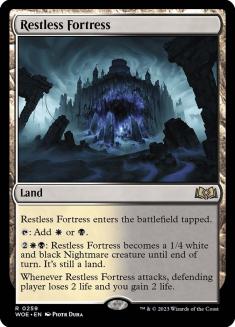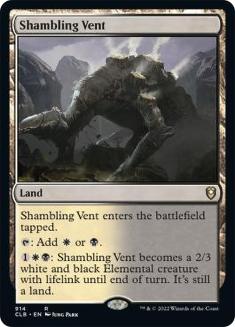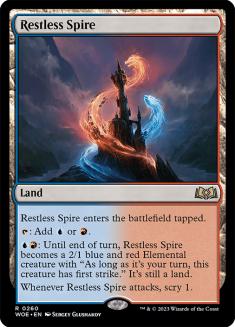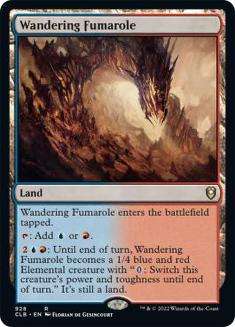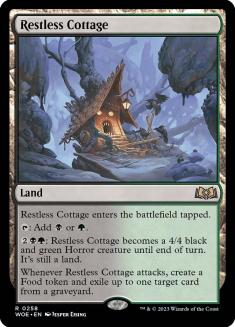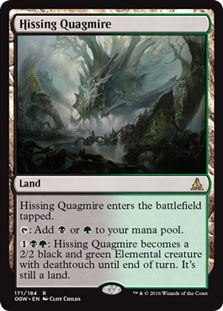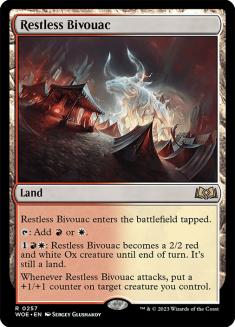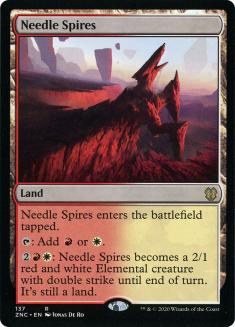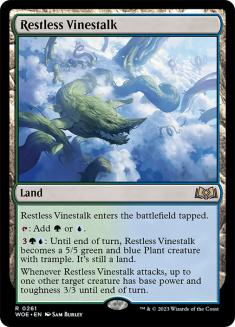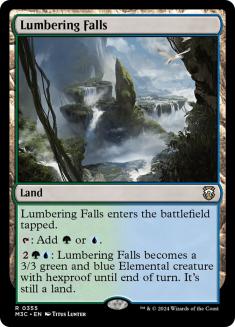Howdy, gamers! The Lost Caverns of Ixalan has already proven to be a very impactful set on Constructed Magic, and I’m happy to report that I’ve really been enjoying a lot of the new cards in Cube as well. Some of the more noteworthy cards are the completion of the new creature dual land cycle, which I made note of while eschewing from my official Top 10 list. Today I’d like to take the opportunity to focus in on the entire Restless land cycle, with specific attention to how these lands to compare to the original creature duals from Worldwake and Battle for Zendikar.
These cards have all seen heavy Cube play since their original printings and plenty of play in other formats as well, so I imagine I don’t need to spend any time today introducing you to Celestial Colonnade. Now that we have two full cycles of creature duals, some members of one or both cycles will just show up in Cubes less often, as two full cycles of tapped lands take up a lot of slots. Some Cubes will feature all twenty of these lands, and some Cubes will feature zero! There will also be many Cubes that feature some number in-between. Let’s take a closer look at each Restless land as compared to its predecessor by color to determine what sorts of Cubes each card fits into!
Restless Anchorage VS Celestial Colonnade
This is one of the more interesting head-to-heads, as both of these cards are excellent. As we know, Maps are quite a bit weaker than Clues, but they’re still valuable game pieces. Being able to generate a Map every turn with a flying body will help you break through a battlefield stall, and the price is right for the activation cost on Restless Anchorage. I’ve been very impressed with the card playing it so far.
That said, Azorius decks in Cubes, at least at higher power levels, tend to be more about cards like Teferi, Hero of Dominaria than Spell Queller. It’s also often the case that creature-focused Azorius themes in Cube will be more interested in blinking their creatures than growing them. Restless Anchorage is a powerful card, but the one point against it is that Azorius decks just aren’t always interested in this sort of thing.
I currently have Celestial Colonnade in the original Twobert and Restless Anchorage in Spooky Cube, with Spooky Cube caring both about creature combat and graveyards. There’s also room for Restless Anchorage in environments that care about artifacts as a card type. In general, I would feature Restless Anchorage in Cubes that somehow synergize with the card and Celestial Colonnade in Cubes that are more about abstract power level.
Restless Reef VS Creeping Tar Pit
The comparison between Restless Reef and Creeping Tar Pit is… not as close. I generally avoid effects that mill the opponent in Cube, as it is dissatisfying to see your most powerful cards milled and to have running out of cards be the way that the game ends, barring combo finishes like Brain Freeze that only happen in high-power environments anyway. I do like self-mill quite a lot, though I’m not sure how well a 4/4 deathtouch attacking land fits into a self-mill strategy. It’s an odd enabler, to say the least.
Creeping Tar Pit is just an all-timer at turning the corner in a damage race, punishing opponents who play things a little fast and loose with their life totals, and stealing the initiative or monarchy. Restless Reef is unlikely to ever have a home in any of my Cube designs, though it does offer something to Cubes specifically looking for the mill effect. It’s probably a middle-of-the-pack entry on power level, but the mill is so undesirable for my preferred experience and Creeping Tar Pit is so awesome that it’s firmly in my bottom three for creature duals that I would want to Cube with.
Restless Vents VS Lavaclaw Reaches
While we’re talking about bottom three entries and wide deltas between old and new creature duals, Restless Vents is by far the most convincing upgrade over Lavaclaw Reaches of any Restless land. I’ve outright excluded Lavaclaw Reaches from Cubes featuring every other creature dual before an alternative even existed. I would begrudgingly have accepted about any other Rakdos land that they printed, but as it happens, Restless Vents offers exactly what a Rakdos deck wants: an evasive body and some card filtering.
I suspect that Lavaclaw Reaches will mostly only continue to have a home in Cubes appealing to the nostalgia of the era when it was printed or in Midrange Cubes that just want to go heavy on creature duals as mana sinks. For the purpose of my Cubes, I couldn’t retire the Lavaclaw Reaches quickly enough.
Restless Ridgeline Vs. Raging Ravine
Restless Ridgeline might offer the closest comparison to its predecessor among the Restless lands, with minor give and take in either direction. With the activation costs being the same and the bodies being fairly comparable sizes with comparable damage output over a couple of turns, there’s not a lot to say here. Restless Ridgeline untapping and pumping another creature is nice, but so is Raging Ravine’s ability to grow itself over time.
With the comparison being so close, the nostalgia factor makes Raging Ravine the clear choice for me, but in a Cube that’s long on Gruul creatures with trample, there are good incentives to go for the Ridgeline instead. I really couldn’t fault anyone for choosing one of these cards over the other, or for just including both to support more midrange Gruul decks.
Restless Prairie VS Stirring Wildwood
The Anthem ability on Restless Prairie will make this an open-and-shut case for a lot of Cubes, especially with how popular token strategies are when it comes to the white column in Cube. That said, Restless Prairie does cost one additional mana to activate and is much worse at blocking. I know that blocking isn’t the most exciting thing, but it matters in Midrange Cubes for protecting your planeswalkers or just more generally holding off opposing attacks.
I’m keeping Stirring Wildwood in the original Twobert, and I’ve opted to add Restless Prairie to Spooky Cube. Any kind of support for go-wide strategies offers a great home for Restless Prairie, and Stirring Wildwood is still a solid option for its relative efficiency when it comes to Midrange slugfests. I would expect Restless Prairie to be the choice for the majority of Cubes, but Stirring Wildwood is still a reasonable creature dual in its own right.
Restless Fortress VS Shambling Vent
Restless Fortress and Shambling Vent are both among the weaker members of their respective cycles. Both cards offer a little lifegain as their most relevant upsides, which is fairly minor relative to other members of either cycle. A 2/3 for three and a 1/4 for four are both terribly unexciting bodies.
If Restless Fortress triggered when it blocked, I think you could make the case that it was a significant upgrade over Shambling Vent, but as things stand. I favor Shambling Vent for being cheaper to activate and being interchangeable in a very wide range of circumstances. The fourth point of toughness helps Restless Fortress survive some things that Shambling Vent can’t, but I can’t think of a lot of situations where that matters much at all given the additional cost to activate. Give me Shambling Vent every time.
Restless Spire VS Wandering Fumarole
Restless Spire got some buzz when it was first previewed for having such a cheap activation cost, and Wandering Fumarole is a favorite of few players. That said, Restless Spire is close to useless as a blocker and is only an okay attacker in a world where we’re starting to see more and more two-mana 2/3s and creatures are just generally more playable. Restless Spire would be awesome in an old-school control mirror, but the card really doesn’t offer much in 2023.
My experience with Wandering Fumarole is that it can be a really irritating potential blocker while also threatening a ton of damage on the way back. I expect Restless Spire to show up in a lot of Cubes, though I am personally sticking to Wandering Fumarole in all of my current designs. Where I could see Restless Spire really shining is in a Cube with an especially low mana curve. If I were to add creature duals to the Tempo Twobert, for example, Restless Spire would be a lock.
Restless Cottage VS Hissing Quagmire
The thing that Hissing Quagmire was best at was blocking and trading, or at least threatening to do so. The card was most appealing for having a relatively cheap activation cost. Restless Cottage costs one more to activate, but is massive, offers some graveyard interaction, and supplies a Food to gain life or get up to something more nefarious in the right environment. Restless Cottage is excellent, but I wouldn’t say that Hissing Quagmire is bad.
In fact, I think that Golgari as a two-color pair offers one of the most compelling cases to feature both of its on-color creature duals. They’re both just generically playable rates, and Golgari is so commonly supported as some manner of midrange archetype in Cube that I would happily play both lands in almost any Golgari deck. Add some cards like Sylvan Advocate and Blossoming Tortoise to the mix, and there’s a lot to like about going heavy on green creature lands.
Restless Bivouac VS Needle Spires
Restless Bivouac is something of a mini-Raging Ravine that can spread the love around instead of just growing itself. This can be very relevant as you navigate the equation of how often you’ll be activating your land to attack on future turns. Sometimes you expect that you’ll be facing open mana or different blockers on future turns so you grow a different creature, and often enough you just grow the Bivouac itself. Having that option is very powerful if you’re heads-up about what to grow.
Needle Spires, on the other hand, has always been a little too inefficient to really matter. There’s a lot of pressure on Boros decks to spend their mana every turn and end the game quickly, and that pressure also makes lands that enter the battlefield tapped a risky proposition. Not to mention that it just dies to everything. Needle Spires just didn’t offer enough to matter as often as it needed to, and Restless Bivouac is a marked improvement.
Restless Vinestalk VS Lumbering Falls
Restless Vinestalk costs one more mana than Lumbering Falls to activate, but it offers a lot more than one additional mana in combat relevance. Being able to grow a mana creature to attack or shrink an opposing big blocker are both situationally powerful options for Restless Vinestalk’s attack trigger that make the card very appealing.
What I will say for Lumbering Falls is that hexproof is a powerful ability to have on a creature-land. Creature-lands tend to be at their most relevant against control decks, particularly as a way to play around counterspells, and hexproof means that Lumbering Falls also plays around removal. It’s not the best against opposing blockers, but hexproof is relevant enough that Restless Vinestalk isn’t an out-and-out upgrade. I’ve chosen to keep Lumbering Falls in the original Twobert specifically for its strength against spot removal, though I would expect more Cubes to reach for the Vinestalk on abstract power level.
I wasn’t sure if or when we would see this cycle completed, and I’m very pleased to now have two full cycles of creature duals for Cube. Every color pair now has at least one powerful option, though Orzhov and Izzet admittedly have less going for them than the other guilds. Even still, creature-lands are awesome mana sinks for Cube, and mana-fixing such an important aspect of compelling Cube Drafts, that I love having these new options to explore. 2023 is going out with a bang on The Lost Caverns of Ixalan, and I couldn’t be happier to see it.

